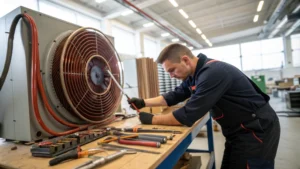All right, so you guys really seem to be into heating rings lately. You've sent us a ton of stuff about installation.
Yeah, it seems like a lot of people want to learn how to install them. Right.
So we're going to take a deep dive into all that material today, see what we can uncover and.
Yeah, and we'll try to answer as many of your questions as we can.
Exactly. All right, so from what I've seen, the sources really stress the importance of prep work.
Oh, yeah, big time. They really emphasize that you got to get ready before you even touch the coil.
Kind of like planning a road trip, right?
Exactly. You wouldn't just hit the road without checking your car first, would you?
Definitely not. So in this case, our car is the heating coil and the barrel. It's going on too.
Right. And we need to make sure both of them are in tip top shape before we even think about fitting them together.
Okay, so walk me through this pre game checklist. What exactly are we looking for when we inspect the coil in the barrel?
Well, first off, you want to look for any kind of damage, you know, cracks, deformations, even tiny scratches.
Scratches, really?
Yeah. One source even mentioned a story where this tiny little scratch on the coil ended up causing a huge problem later on.
Wow. So it's really all about the details.
Absolutely. You don't want to overlook anything.
Okay, so let's say we've inspected both parts and they look good. What's next?
Well, then you got to make sure they're actually compatible with each other.
Compatible how?
So you got to check the specs. You know, things like the size, inner diameter, power requirements, all that stuff.
So it's like trying to fit a square peg in a round hole.
Exactly. It's just not going to work. And in the case of heating rings, a mismatch could be disastrous.
Okay, got it. So we've inspected, we've confirmed compatibility. Now comes the fun part. Actually fitting the coil onto the barrel.
Right. And this is where things can get a little tricky.
So what's the key to getting that perfect fit?
Well, the most important thing is to make sure the coil is snug against the barrel.
Why is that so important?
Because a snug fit means optimal heat transfer.
Hmm, I don't quite follow.
Okay, so heat energy always flows from hotter objects to cooler ones, right?
Yeah, that's basic thermodynamics.
Exactly. So when the coil is tightly fitted against the barrel, the heat can flow smoothly and efficiently.
But if there are gaps, then the.
Heat transfer gets disrupted because air is a really bad conductor of heat. Any air gaps between the coil and the barrel act as insulation.
Ah, I see. So it's like trying to heat your house with the windows open.
Exactly. The heat just escapes and you end up wasting a lot of energy.
Okay, so a snug fit is crucial, but how do we actually achieve that?
Well, the sources recommend gently rotating the coil onto the barrel.
Rotating it?
Yeah, you kind of have to finesse it in there. Make sure it sits flush and tight against the barrel.
So no air gaps whatsoever.
Exactly.
Sounds like a puzzle.
It can be kind of like that. Yeah, but once you get it right, it's really satisfying.
Okay, so we've got that nice snug fit. Now how do we make sure the coil stays put?
That's where clamps or bolts come in.
Ah, so we're basically clamping the coil onto the barrel.
Yep, that's the idea.
But I imagine you have to be careful not to overtighten them.
Oh, absolutely. Too much force can damage the coil or the barrel.
So what's the sweet spot?
Well, the best thing to do is follow the manufacturer's instructions. They usually specify the right amount of torque.
Okay, makes sense. You wouldn't want to over tighten a jar lid and craft the glass.
Exactly. It's all about finding the right balance.
Alright, so we've prepped the coil and the barrel, we've fitted them together nice and snug and we've secured everything with clamps or bolts. What's next?
Now we gotta talk about electrical connections.
Ah, the heart of the operation.
And this is where safety becomes absolutely paramount.
Yeah, we're dealing with heat and electricity. Not exactly combination you want to mess around with. Nope.
So we gotta be extra careful.
What are the key things to keep in mind when making those connections?
Well, first of all, you need to inspect the wires really carefully, make sure there's no damage or fraying.
Kind of like checking your bike tires before a ride.
Exactly. You don't want to have any surprises on the road or in this case, any electrical shocks.
So no frayed wires.
Yeah, got it.
What else?
Well, you got to make sure the wires are the right size for the power requirements of your heating coil.
Ah, so it's like making sure you have the right tires for your bike.
Exactly. You wouldn't put mountain bike tires on a road bike, would you?
Nope, definitely not.
And then of course, you gotta use the right terminals or plugs for the wires and the power source.
Why is that so important?
Because those connections need to be secure. You don't Want any loose wires or arsing?
Aren't you gooey?
Yeah, that's when electricity jumps between two conductors, it can be incredibly dangerous.
Yikes. Okay, so secure connections are key. What else should we be looking out for?
Well, one of the sources mentioned some something called an insulation resistance meter.
What's that?
It's a tool that measures the resistance between the conductors in the wire and the ground.
Hmm, I'm not sure I understand.
Basically it helps make sure that the electricity is flowing where it's supposed to and not leaking out where it shouldn't.
Ah, so it's like a safety net.
Exactly. It's a simple test that can prevent a lot of problems down the line.
Okay, so we've inspected the wires, we've made sure they're the right size and we've used the right terminals, and we've checked the insulation resistance. What's next?
Well, before we even think about powering up the heating ring, we need to do some post installation testing.
Testing?
Yeah, we gotta make sure everything is working properly before we unleash the full power of this thing.
Makes sense. So what is this post installation testing involve?
Well, it's a multi stage process. The first stage is a visual inspection.
A visual inspection?
Yep. Remember all those tiny scratches and imperfections we were looking for earlier? Okay, well now's the time to double check that we didn't miss anything and that nothing got damaged during the installation.
So it's like a final quality control check.
Exactly.
And once we're happy with the visual inspection, what's next?
Then we gotta revisit those electrical connections, make sure everything is still tight and secure.
Ah, right, because even a slightly loose connection can cause problems.
Exactly.
Okay, so visual inspection, electrical connections, check and check. What's the next stage of testing?
The next stage is the preliminary power on test.
Oh, this is where we get to see if it actually works.
Yep, this is the moment of truth.
But I imagine it can also be a little nerve wracking.
Oh yeah, definitely. You're always a little apprehensive when you first power up something like this.
So what are we looking for during this initial power on?
We're listening for any unusual sounds, watching for any signs of smoke or sparks, basically making sure everything is behaving as it should.
Kind of like taking a brand new car for a test drive.
Exactly. You're excited, but you're also being cautious.
Okay, so if everything looks and sounds good during the preliminary power on, what's next?
Then we move on to the final stage of testing. Functional testing.
Functional. Testing?
Yeah. This is where we really put the heating ring through its cases. We run it at different power levels, check the temperature regulation, make sure it's performing according to the specs.
Ah, so it's like the final exam.
Exactly. If the heating ring passes this test, it graduates with honors, and then we.
Can finally breathe a sigh of relief.
Yep. We know we've done everything right.
So we've covered a lot of ground here, from prepping the coil and barrel to securing those electrical connections and conducting thorough post installation tests. But it seems like the forces don't stop there.
Nope. They go even deeper.
They talk about all sorts of expert tips and resources for those who want to become true heating ring masters.
Right. They point to all sorts of advanced guides and troubleshooting techniques.
So it's like taking a masterclass after you've completed the introductory course.
Exactly. They want to make sure you have all the knowledge and skills you need to become a heating ring expert.
That's awesome. So let's dive into those expert tips and resources and see what kind of gems we can uncover.
Sounds good to me.
All right, then, let's take a quick break, and we'll be right back with more heating ring goodness.
Stay tuned, folks.
We'll be right back.
Welcome back, folks. So before the break, we were talking about all these expert tips and resources.
Yeah. It seems like there's a whole world of advanced knowledge out there for those who really want to get into the nitty gritty of heating rings.
Absolutely. And you know, these resources go way beyond just basic installation.
Oh, yeah. They delve into all sorts of specialized areas. Like those detailed guides on post installation testing we mentioned earlier.
Exactly. Those guides are like a treasure trove of troubleshooting tips and tricks.
So can you give me an example of what kind of stuff these guides might cover?
Sure. Let's say you've finished installing your heating ring and you're running those final functional tests.
Okay.
And you notice that the ring isn't reaching the desired temperature even though you followed all the steps carefully. Well, these advanced guides might have specific troubleshooting strategies for that exact scenario.
Ah, so it's like having a specialized toolkit for diagnosing and fixing heating ring problems.
Exactly. They might guide you through checking the resistance of the heating element, verifying the accuracy of your temperature controller, or even identifying potential issues with the power supply.
Wow. So it gets pretty technical.
It can. Yeah. But these guides break it down in a way that's easy to understand even if you're not an electrician.
That's Great, because I know a lot of people are intimidated by electrical stuff.
Yeah. And, you know, these resources aren't just about troubleshooting. They also cover things like preventative maintenance.
Preventative maintenance?
Yeah. Think of it like taking your car in for regular checkups. You might not have any problems right now, but those checkups can help prevent major issues down the line.
Ah, I see. So what kind of preventative maintenance tips might these guides offer for heating rings?
Well, they might cover things like cleaning the heating element, inspecting the wiring for wear and tear, or even calibrating the temperature controller for optimal accuracy.
So it's all about keeping your heating ring in tip top shape.
Exactly. You want it to run smoothly and efficiently for years to come, and these.
Guides can help you do just that.
Absolutely. They're like a personal mentor for your heating ring.
Okay, so we've covered the entire installation process, from prep work to post installation testing, and we've even touched on the world of expert tips and resources.
Yep, we've pretty much covered all the bases.
So what's the main takeaway here for our listeners?
Well, I think the most important message is that installing a heating ring doesn't have to be a daunting task.
Right. It might seem complicated at first, but.
With the right knowledge and a methodical approach, anyone can do it.
It's all about breaking down the process into manageable steps and understanding the why behind each step.
Exactly. And you know, there's a ton of information out there to help you along the way.
Yeah. Those expert resources we talked about are a goldmine of knowledge.
Don't be afraid to tap into those resources if you need help.
All right, so armed with all this knowledge, our listener is now ready to embark on their own heating ring installation adventure?
I think so. Yeah.
But before we wrap things up, I want to leave you with one final thought.
Okay.
We've talked a lot about the importance of a tight fit, secure connections, thorough testing, all that good stuff.
Right.
But what if, despite all your best efforts, something still goes wrong?
That's a good question.
What if you've done everything by the book, but the heating ring just isn't performing as expected?
Well, in that case, you need to put on your detective hat and figure out what's causing the problem.
So it's all about troubleshooting.
Exactly. You need to use your knowledge of the system to identify the root cause of the issue.
So where would you start your investigation if you were faced with a heating ring that wasn't working properly?
Well, I'd start by checking for any Obvious signs of damage. You know, loose connections, burnt wires, anything like that.
Ah. So start with the basics.
Yep. And then if I don't see anything obvious, I'd move on to more advanced diagnostic techniques.
Like what?
Well, I might test the electrical continuity of the circuit or analyze the temperature readings to see if there's a pattern to the malfunction.
So it's all about systematically narrowing down the possibilities until you find the culprit.
Exactly. And, you know, if you get stuck, don't be afraid to reach out for help.
Right. There's no shame in asking for assistance.
Nope. Those expert resources we talked about can be a lifesaver in tricky situations.
Okay, so troubleshooting is all about using your knowledge to analyze the situation and solve the problem.
That's a great way to put it.
It's like being a heating ring detective.
Exactly.
All right, so as we wrap up this part of our deep dive, I want to emphasize that learning is a continuous process.
Oh, yeah, absolutely.
There's always more to learn about heating rings and the world of heating technology in general.
And, you know, the more you learn, the more confident and capable you'll become.
So keep that curiosity burning, folks.
Yeah.
And never stop exploring.
That's what it's all about.
All right, so let's take another quick break, and then we'll come back for the final part of our deep dive.
Sounds good to me.
We've been through a lot, haven't we? Talking about all this heating ring stuff.
Yeah. It's amazing how much there is to learn about something that seems so simple on the surface.
Right. Like, who knew there was so much to consider when installing one of these things?
It's definitely more than just plugging it in and turning it on.
Absolutely. We've talked about the importance of a tight fit, secure connections, thorough testing, and troubleshooting, too.
Right. You can't forget about that.
Of course, if something goes wrong, you gotta know how to fix it.
Exactly. And that's where all that knowledge and understanding comes in handy.
So, as we wrap up this deep dive, I wanna leave you with one final thought. Imagine you've just finished installing your heating ring.
Okay.
It's working perfectly. Radiating that nice, even heat. You're feeling pretty good about yourself, right?
Definitely. All that hard work paid off.
So what are you most proud of? Is it the meticulous preparation? The perfectly snug fit? The secure connections? The rigorous testing? Or maybe even the problem solving skills you picked up along the way?
Hmm, That's a tough one. I think I'd be most proud of the fact that I took the time to really understand the process.
Ah, so it's not just about the end result, it's about the journey.
Exactly. It's about learning and growing and becoming more confident in your abilities.
I like that. And you know what? That's a great message to end on.
What's that?
It's not just about heating rings. It's about everything in life.
I see what you mean.
If you take the time to learn and understand, you can accomplish anything.
Absolutely. Well said.
So to our listener, we say, congratulations on completing this deep dive into heating ring installation.
We hope you enjoyed it.
And remember, this is just the beginning. Keep that curiosity burning. Never stop learning. And who knows? Maybe you'll become the next heating ring master.
That would be awesome.
Until next time, happy heating,




